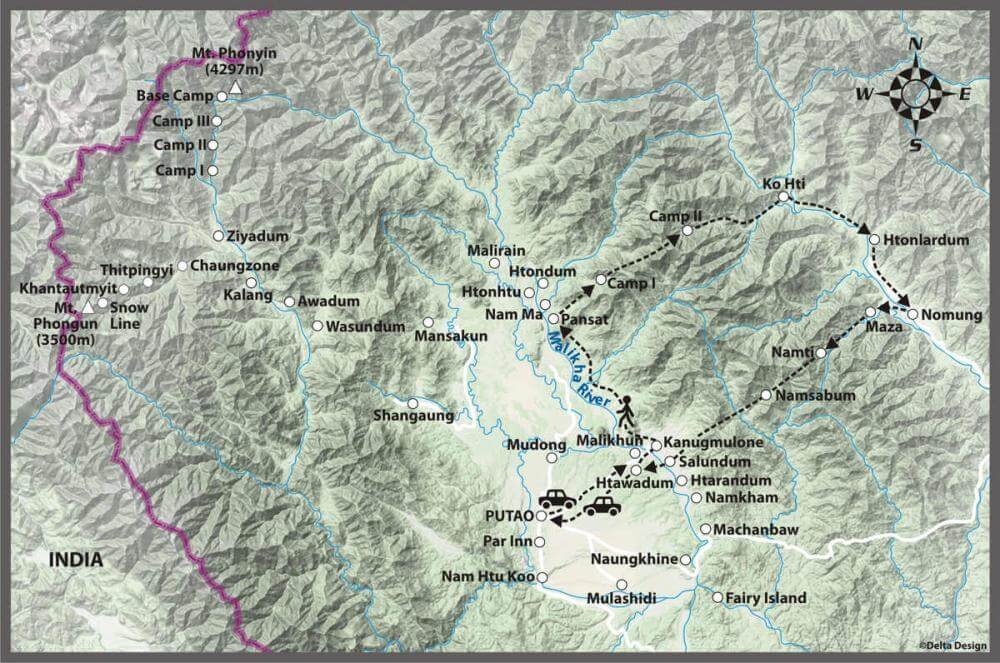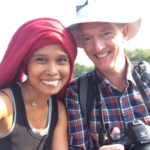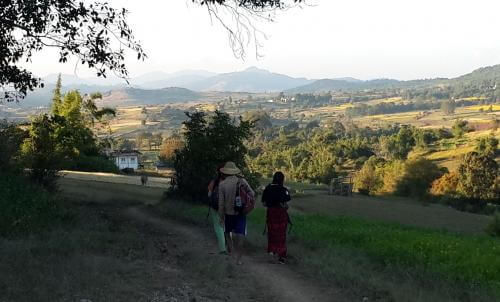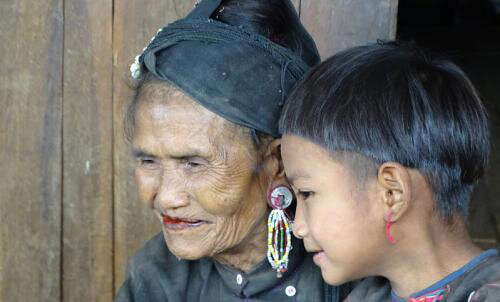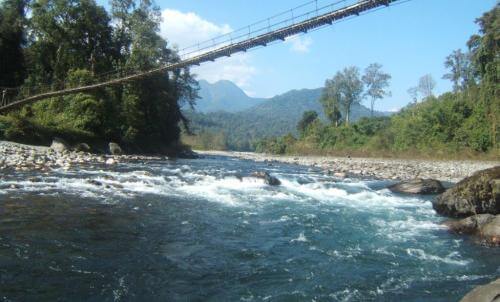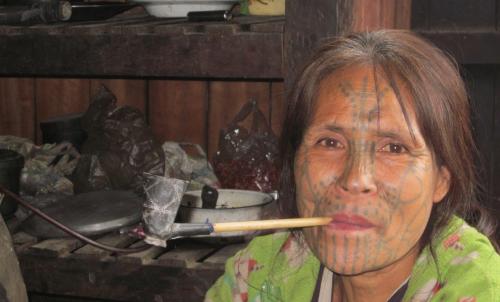10 Days / 9 Nights Putao – The last frontier
starting from $2764
Nomung, situated 125 km north of Putao at an altitude of 1.640 feet (500 metres) above sea is the administrative center of the Hkakaborazi National Park system, witnessing heavily forested jungle with rich flora and fauna. Being depot of botany in northern Myanmar having a huge range of flowers including Rhododendron Dendricoala and many deferent species of Begonias etc. This is the very place that well-known botanist Frank Kingdon Ward has found many rare species of orchids during his botanic survey in 1920.
MANDALAY - PUTAO - KANUGMULON - PANSAT - CAMP I - CAMP II - LO HTI - HTONLARDUM - NOMUNG - MAZA - NAMTI - NAMSABUM - PUTAO - MANDALAY
| Type of trip: |
Individual tour
|
|---|---|
| Price: |
starting from $2764 (based on 2 travellers)
|
| Availability: | Not available |
| Start of the trip: | None |
| Difficulty: | demanding |
- 2 nights including breakfast at Putao Trekking House
- 7 nights in local houses or camps (tents)
- Domestic flights Mandalay – Putao – Mandalay
- Full board as mentioned in our itinerary
- English-speaking, local travel guides for all transfers and tours
- Transfers and transportation in Putao by Jeep
- Permission for Putao
- Cook & porters for the trekking trips
- International flights to/from Myanmar
- Visa fees
- Accommodation in Mandalay
- Lunches and dinners not included in the itinerary
- Drinks
- Early check-in/late check-out
- Personal expenses such as camera fees, tips, laundry, etc.
- Hotel baggage handling fees
Day 01 MANDALAY – PUTAO (D)
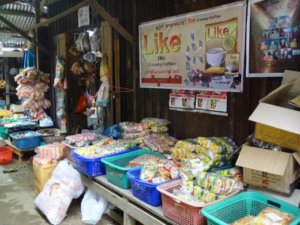 Upon arrival at Putao airport we will be met by Trekking House's representative and transferred to our lodge. Putao lies in a flat valley, jumping-off point for trekkers who want to explore the region’s deep forests, wildlife sanctuaries and snow-capped mountains etc. Putao town and fort was built during 1914-15 by Commissioner Mr. Hertz along with Fort which later known as Fort Hertz. Later a Missionary basing the Rawan and Lisu tribe as initial and introduce Grapefruit, Washington Naval, Vlincha Orange, Ruby Oranges, King Orange and King Mandarin plus America Lime were introduced. After a brief fresh up take a walk around Putao for the orientation. Dinner and overnight at Putao Trekking House.
Upon arrival at Putao airport we will be met by Trekking House's representative and transferred to our lodge. Putao lies in a flat valley, jumping-off point for trekkers who want to explore the region’s deep forests, wildlife sanctuaries and snow-capped mountains etc. Putao town and fort was built during 1914-15 by Commissioner Mr. Hertz along with Fort which later known as Fort Hertz. Later a Missionary basing the Rawan and Lisu tribe as initial and introduce Grapefruit, Washington Naval, Vlincha Orange, Ruby Oranges, King Orange and King Mandarin plus America Lime were introduced. After a brief fresh up take a walk around Putao for the orientation. Dinner and overnight at Putao Trekking House.
Day 02 PUTAO – KANUGMULON – PANSAT (B, L, D)
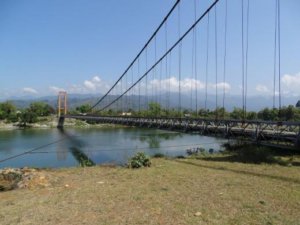 Early in the morning we visit attractive market often busy with local ethnic tribes. Return to hotel, breakfast and depart by jeep/truck through the vast Putao plain on pebbled road toward Htawadum (13 km, one hour). Here we cross Malikha river by newly build suspension bridge and continue travel to Kaungmulone Pagoda site, said to be one of the 84.000 pagodas built by Thiri Dhamma Thawka, the great king. From here we head toward north and walk to Pansat, located at 1.312 feet (400 metres) above sea (13 km, approx. 4 hour). We pass small villages such as Ngwa Saga, Nam Buyan, Zu Ka and Mano crossing several suspension bridges. Pansat, predominantly Rawan tribal village parched by the Malikha River under beautiful Namhti Mountain range. Dinner and overnight at local home.
Early in the morning we visit attractive market often busy with local ethnic tribes. Return to hotel, breakfast and depart by jeep/truck through the vast Putao plain on pebbled road toward Htawadum (13 km, one hour). Here we cross Malikha river by newly build suspension bridge and continue travel to Kaungmulone Pagoda site, said to be one of the 84.000 pagodas built by Thiri Dhamma Thawka, the great king. From here we head toward north and walk to Pansat, located at 1.312 feet (400 metres) above sea (13 km, approx. 4 hour). We pass small villages such as Ngwa Saga, Nam Buyan, Zu Ka and Mano crossing several suspension bridges. Pansat, predominantly Rawan tribal village parched by the Malikha River under beautiful Namhti Mountain range. Dinner and overnight at local home.
Day 03 PANSAT – CAMP I (elevation 1.310 feet (399 metres) to 2.789 feet 850 metres) (B, L, D)
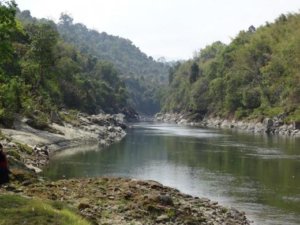
Breakfast and we head north-east towards mountains to our today destination of so-called camp I (17 km, approx. 6 hour). Our trek goes through valley along the creek and relatively easy compare to trek we are about to encounter next a couple of days. Most of the part we traverse huge meadow of tropical rain forests witness thick groove of rattan and vine at the bottom of extremely large trees. Tonight we will us the camp constructed by the construction company when they build the trek path. Dinner and overnight at camp.
Day 04 CAMP I – CAMP II (elevation 2.789 feet (850 metres) to 5.544 feet (1.690 metres) and then to 3.340 feet (1.018 metres) (B, L, D)
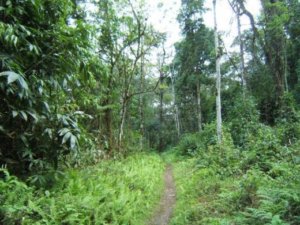 Breakfast and we head east to so-called mountain camp (16 km, approx. 4 hour). Trek goes straight up hill immediate after we start but soon we find ourselves walking on the shoulder of the ridge enjoy the view of snow-capped mountain in the far-east towards China border. Once we get in to some challenging spots crossing stone boulder and narrow cliff, we find quite enjoyable trail through the valley. Lunch stop and we continue trek to our today destination at camp II (6 km, approx. 2 hour). Trail usually goes gently ups and downs through the valley often infested with large bamboo grove. Dinner and overnight at camp.
Breakfast and we head east to so-called mountain camp (16 km, approx. 4 hour). Trek goes straight up hill immediate after we start but soon we find ourselves walking on the shoulder of the ridge enjoy the view of snow-capped mountain in the far-east towards China border. Once we get in to some challenging spots crossing stone boulder and narrow cliff, we find quite enjoyable trail through the valley. Lunch stop and we continue trek to our today destination at camp II (6 km, approx. 2 hour). Trail usually goes gently ups and downs through the valley often infested with large bamboo grove. Dinner and overnight at camp.
Day 05 CAMP II – KO HTI – HTONLARDUM (elevation 3.340 feet (1.018 metres) to 2.987 (910 metres) feet and then to 2.198 feet (670 metres) (B, L, D)
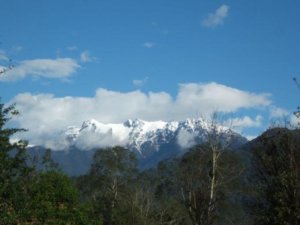 Breakfast and we head east for the river confluence of Phandum and Kasan (3½ km, approx. 1 hour) through the valley infested with thick rain forests and bamboo groove. Once we cross the river with make ship Bamboo Bridge we ten get in to a vast of plain with high vegetation and soon after we encounter human settlement of Ko Hti village (6½ km, approx. 2 hour) from where merely a 30 minute trek gets us to our today destination at Htondum village. We have a late lunch and interact with friendly local community at the village. Dinner and over at local home.
Breakfast and we head east for the river confluence of Phandum and Kasan (3½ km, approx. 1 hour) through the valley infested with thick rain forests and bamboo groove. Once we cross the river with make ship Bamboo Bridge we ten get in to a vast of plain with high vegetation and soon after we encounter human settlement of Ko Hti village (6½ km, approx. 2 hour) from where merely a 30 minute trek gets us to our today destination at Htondum village. We have a late lunch and interact with friendly local community at the village. Dinner and over at local home.
Day 06 HTONLARDUM – NOMUNG (elevation 2.198 feet (670 metres) to 1.640 feet (500 metres) (B, L, D)
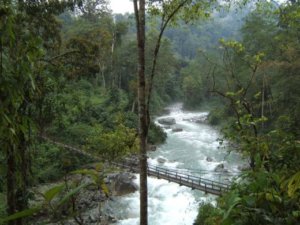 Breakfast and we bit farewell to local and trek to our final destination at Nomung (16 km, approx. 6 hour). Nomung is the administrative township and situates at 1.640 feet (500 metres) above sea. Along the way we enjoying the site and sounds of the pristine vegetation. We spot many beautiful birds and orchids hanging on the large trees. Once we descend towards lowland we trek along the creek with plantations belong to the village. Lunch at restaurant and we enjoy an easy afternoon culturally and socially interaction with the locals. Dinner and overnight at local guesthouse.
Breakfast and we bit farewell to local and trek to our final destination at Nomung (16 km, approx. 6 hour). Nomung is the administrative township and situates at 1.640 feet (500 metres) above sea. Along the way we enjoying the site and sounds of the pristine vegetation. We spot many beautiful birds and orchids hanging on the large trees. Once we descend towards lowland we trek along the creek with plantations belong to the village. Lunch at restaurant and we enjoy an easy afternoon culturally and socially interaction with the locals. Dinner and overnight at local guesthouse.
Day 07 NOMUNG – MAZA (elevation 1.640 feet (500 metres) to 3.176 feet (968 metres) (B, L, D)
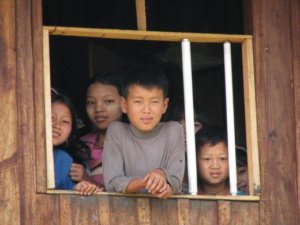 Breakfast and we have had a relaxing day at Nomung. Later we head west and trek to Maza, locates at 3.363 feet (1.025 metres) above sea (11½ km, approx. 5 hour). At first we cross Kasan creek by bridge and then traverse through the plain with paddy fields along the stream. Once we left to valley turning south our trail goes constantly uphill all the way to Maza camp. Maza has two different camp constructed by road construction company and local Christian Church. Dinner and overnight at camp house.
Breakfast and we have had a relaxing day at Nomung. Later we head west and trek to Maza, locates at 3.363 feet (1.025 metres) above sea (11½ km, approx. 5 hour). At first we cross Kasan creek by bridge and then traverse through the plain with paddy fields along the stream. Once we left to valley turning south our trail goes constantly uphill all the way to Maza camp. Maza has two different camp constructed by road construction company and local Christian Church. Dinner and overnight at camp house.
Day 08 MAZA – NAMTI (elevation 3.176 feet (968 metres) to 5.754 feet (1.754 metres) and then to 2.972 feet 906 metres) (B,L,D)
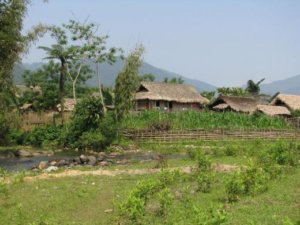 Breakfast turn your direction to south-west towards Namti, situate at 2.300 feet (701 metres) above sea (19 km, approx. 6 hours). First 6 km will be up hill towards the shoulder of 6.150 feet (1.875 metres) Mt. Babulonhtan (locally known as Noi Ngum) by winding route through its top. Along the way you will witness many different species of orchid along with birds. If weather permits you will enjoy a spectacular view of snowcapped Mountains in the far north. There will be snow on the top of this mountain during winter months. This is the very place that well-known botanist Frank Kingdon Ward has found many rare species of orchids during his botanic survey in 1920. Some of the rare orchids such as Phiopedilum Wadii or Cypripedium Wardlamon (generally known as black orchid) which has been named after the founder believe can only be seen in Myanmar. Beside black orchid there are many different species of orchids can be found here such as Indrovian, Clanthi, Simpidium, and Simpripedium etc. Noiwinlit and Babulonhtan valley actually is the depot of botany in northern Myanmar having a huge range of flowers including Rhododendron Dendricoala and many deferent species of Begonias etc. Lunch on the way, dinner and overnight at one of the local homes.
Breakfast turn your direction to south-west towards Namti, situate at 2.300 feet (701 metres) above sea (19 km, approx. 6 hours). First 6 km will be up hill towards the shoulder of 6.150 feet (1.875 metres) Mt. Babulonhtan (locally known as Noi Ngum) by winding route through its top. Along the way you will witness many different species of orchid along with birds. If weather permits you will enjoy a spectacular view of snowcapped Mountains in the far north. There will be snow on the top of this mountain during winter months. This is the very place that well-known botanist Frank Kingdon Ward has found many rare species of orchids during his botanic survey in 1920. Some of the rare orchids such as Phiopedilum Wadii or Cypripedium Wardlamon (generally known as black orchid) which has been named after the founder believe can only be seen in Myanmar. Beside black orchid there are many different species of orchids can be found here such as Indrovian, Clanthi, Simpidium, and Simpripedium etc. Noiwinlit and Babulonhtan valley actually is the depot of botany in northern Myanmar having a huge range of flowers including Rhododendron Dendricoala and many deferent species of Begonias etc. Lunch on the way, dinner and overnight at one of the local homes.
Day 09 NAMTHI – NAMSABUM – PUTAO (elevation 2.972 feet (906 metres) to 1.883 feet (559 metres) then 1.499 feet (457 metres) (B, L, D)
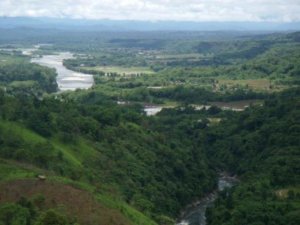 Breakfast and keep trek through winding mule trek to Namsabum (15 km, approx. 5 hours). Once climb on Noiwinlit Mt. 4.525 feet (1.380 metres) you will see snake like crawling Namti creek down in the bottom of valley from the distance. Once cross Htikha creek by a suspension bridge the trek goes through up hills and then to downhill all the way to Namsabum. On the way witness heavily forested jungle, groups of monkeys were jumping everywhere making loud noise. Continue trek to Salundum (5 km, approx. 2 hours) on a relatively easy path. Once cross Malikha river by boat to Htawadum, your jeep awaits you and takes you back to Putao. Farewell dinner with fellow group members, including your porters, and commemorate the experience that you have shared for the past 10 days in this unique part of the world. Overnight at Putao Trekking House.
Breakfast and keep trek through winding mule trek to Namsabum (15 km, approx. 5 hours). Once climb on Noiwinlit Mt. 4.525 feet (1.380 metres) you will see snake like crawling Namti creek down in the bottom of valley from the distance. Once cross Htikha creek by a suspension bridge the trek goes through up hills and then to downhill all the way to Namsabum. On the way witness heavily forested jungle, groups of monkeys were jumping everywhere making loud noise. Continue trek to Salundum (5 km, approx. 2 hours) on a relatively easy path. Once cross Malikha river by boat to Htawadum, your jeep awaits you and takes you back to Putao. Farewell dinner with fellow group members, including your porters, and commemorate the experience that you have shared for the past 10 days in this unique part of the world. Overnight at Putao Trekking House.
Day 10 PUTAO – MANDALAY (B, L)
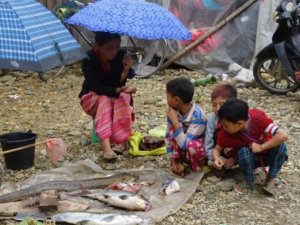 Breakfast and perhaps a last minute shopping at Putao market and further visit in and around Putao with suggestion by your guide. Lunch and afternoon transfer to airport for your flight to Mandalay.
Breakfast and perhaps a last minute shopping at Putao market and further visit in and around Putao with suggestion by your guide. Lunch and afternoon transfer to airport for your flight to Mandalay.
PRICES IN US$ PER PERSON VALID FROM 01.11.2020 BIS 31.05.2021
| 01.11.20-28.02.21 | 01.03.21-31.05.21 | |
|---|---|---|
|
1 person
|
4.158
|
3.985
|
|
2 people
|
2.764
|
2.654
|
|
3 people
|
2.240
|
2.150
|
|
4 people
|
2.013
|
1.932
|
|
5 people
|
1.890
|
1.814
|
|
6 people
|
1.794
|
1.722
|
|
Single supplement
|
180
|
173
|
Supplement for German speaking guide: US$ 3.960 per group
Supplement for Italian- or Spanish speaking guide: US$ 3.840 per group
PERSONAL ITEMS TO BRING FOR TREKKING
As a general rule when packing for one of our wilderness expeditions please keep personal gear to a minimum. Clothing should be lightweight, dry quickly, and provide insulation even when wet. Synthetic fibers are preferable to cotton on the river for this reason. For any other personal items not included on our detailed equipment list below, please feel free to contact us directly.
A daypack. It should be a medium volume daypack without a frame, and again, the most important criteria are how well it fits and works.
Lightweight hiking boots or running shoes of good quality and preferably worn in are a must. For people who do not routinely walk in the mountains, light hiking boots are strongly recommended. Heavy mountaineering boots are not recommended.
For longer treks and Higher Altitude treks waterproof pants, gaiters, additional socks and thermal hats and gloves are highly recommended.
Lightweight pants and jacket. The brushed nylon pants and windbreakers made by a variety of companies are ideal for trekking and general travel wear.
Long sleeved thermal, top and bottoms (long underwear). These are synthetic clothing such as Patagonia Capaline which maintain their insulating value even when wet, and are therefore ideal for wearing around the campsite and on the river. The zippered turtleneck is particularly handy, as it can be vented and keeps the sun off the back of your neck. Light and medium weight weaves are the handiest.
Socks: Two pairs of polypropylene or polypro mix athletic socks.
Cotton underwear.
Lightweight long sleeved shirt. These are particularly useful as sunscreen in camp. In addition temperatures in the shade remain cool throughout the season
Two cotton T-shirts.
A fleece jacket. Polypropylene is preferable.
A Gore-Tex or similar material raincoat and pants. This will keep you warm and dry in a variety of situations. A simple shell design is preferable, as they can be packed away into very small bundles.
Small Towel
Toiletries: keep it to a minimum. Bring plenty of moisturizing lotion.
Spare glasses or contact lenses if you wear them.
Flashlight or headlamp with spare batteries.
Water bottle
Toilet paper and lighter –We do provide it on all trips, but also advise you carry your own supply for convenience. The lighter is for burning the toilet paper after you’ve used it.
Insect Repellent: Our Nam Lang river camp has screened areas where insects are not a problem, but while trekking and rafting in the jungle bring plenty of insect repellent.
Lightweight cotton gloves are also handy as additional insect protection.
Sunscreen (SPF 15 or greater and waterproof) is essential
Lip Balm, SPF 15 minimum
Optional:
Camera and film. Also bring a good cleaning kit, as field conditions are harsher than in towns. Spare batteries are also handy. There will be waterproof Pelican Cases supplied on the rafting trips. Packets of silica gel will help reduce humidity in the camera case.
Small binoculars for wildlife viewing. If you’re an avid bird watcher you may want to bring a more substantial pair of binoculars with a waterproof case.
Pocketknife or multi-tool.
Do you have any questions?
Feel free to contact us. our team will be happy to help you.

